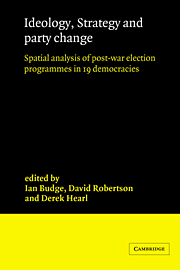 Ideology, Strategy and Party Change
Ideology, Strategy and Party Change Book contents
- Frontmatter
- Contents
- List of Tables
- List of Figures
- Preface
- 1 The influence of election programmes: Britain and Canada 1945–1979.
- 2 The internal analysis of election programmes.
- 3 Britain, Australia, New Zealand and the United States 1946–1981, an initial comparative analysis.
- 4 Canada 1945–1980: party platforms and campaign strategies.
- 5 Sri Lanka 1947–1977: elite programmes and mass politics.
- 6 Israel 1949–1981.
- 7 Ireland 1948–1981: issues, parties, strategies.
- 8 Northern Ireland 1921–1973: party manifestos and platforms.
- 9 Sweden and Denmark 1945–1982: election programmes in the Scandinavian setting.
- 10 The Netherlands 1946–1981.
- 11 Belgium 1946–1981.
- 12 Luxembourg 1945–1982: dimensions and strategies.
- 13 Austria 1945–1978.
- 14 Electoral programmes in West Germany 1949–1980: explorations in the nature of political controversy.
- 15 France 1958–1981: the strategy of joint government platforms.
- 16 Italy 1946–1979: ideological distances and party movements.
- 17 Japan 1960–1980: party programmes in elections.
- 18 Do parties differ, and how? Comparative discriminant and factor analyses.
- Appendices
- General bibliography
- Index
18 - Do parties differ, and how? Comparative discriminant and factor analyses.
Published online by Cambridge University Press: 27 October 2009
- Frontmatter
- Contents
- List of Tables
- List of Figures
- Preface
- 1 The influence of election programmes: Britain and Canada 1945–1979.
- 2 The internal analysis of election programmes.
- 3 Britain, Australia, New Zealand and the United States 1946–1981, an initial comparative analysis.
- 4 Canada 1945–1980: party platforms and campaign strategies.
- 5 Sri Lanka 1947–1977: elite programmes and mass politics.
- 6 Israel 1949–1981.
- 7 Ireland 1948–1981: issues, parties, strategies.
- 8 Northern Ireland 1921–1973: party manifestos and platforms.
- 9 Sweden and Denmark 1945–1982: election programmes in the Scandinavian setting.
- 10 The Netherlands 1946–1981.
- 11 Belgium 1946–1981.
- 12 Luxembourg 1945–1982: dimensions and strategies.
- 13 Austria 1945–1978.
- 14 Electoral programmes in West Germany 1949–1980: explorations in the nature of political controversy.
- 15 France 1958–1981: the strategy of joint government platforms.
- 16 Italy 1946–1979: ideological distances and party movements.
- 17 Japan 1960–1980: party programmes in elections.
- 18 Do parties differ, and how? Comparative discriminant and factor analyses.
- Appendices
- General bibliography
- Index
Summary
SUMMARY AND REVIEW OF THE COUNTRY FINDINGS
Coding
With the exception of Chapters 3 and 9 where we presented parallel but separate analyses of four ‘Anglo-Saxon’ democracies and two Scandinavian systems, each chapter has explored the dimensions and cleavages of party competition, within one country, independently, and in detail. Within the common coding frame of Appendix B, country investigators were free to introduce additional sub-categories to capture the idiosyncracies of their ‘own’ system. It is significant that many did not feel this need, or introduced no more than a few refinements and additions. It is also significant that most country-specific categories introduced at the outset of the coding, on the a priori assumption that they were necessary to accommodate idiosyncracies of the countries involved, were found to collect few references and had to be collapsed back into the general categories.
All this demonstrates that the general coding frame accommodated the major issues of party politics in a very diverse set of countries. It worked least well where it was least relevant, in the basically rural if developing society of Sri Lanka. This was not unexpected, but even here the results made broad sense.
In retrospect, other general coding categories might have been added. This is perhaps more obvious in the External Relations categories than elsewhere, as no direct reference is made to East–West relations nor to the leading alliances such as NATO (though references to foreign special relationships and military pick this up).
- Type
- Chapter
- Information
- Ideology, Strategy and Party ChangeSpatial Analyses of Post-War Election Programmes in 19 Democracies, pp. 388 - 416Publisher: Cambridge University PressPrint publication year: 1987
- 15
- Cited by


